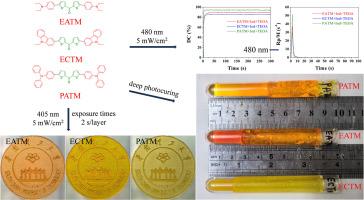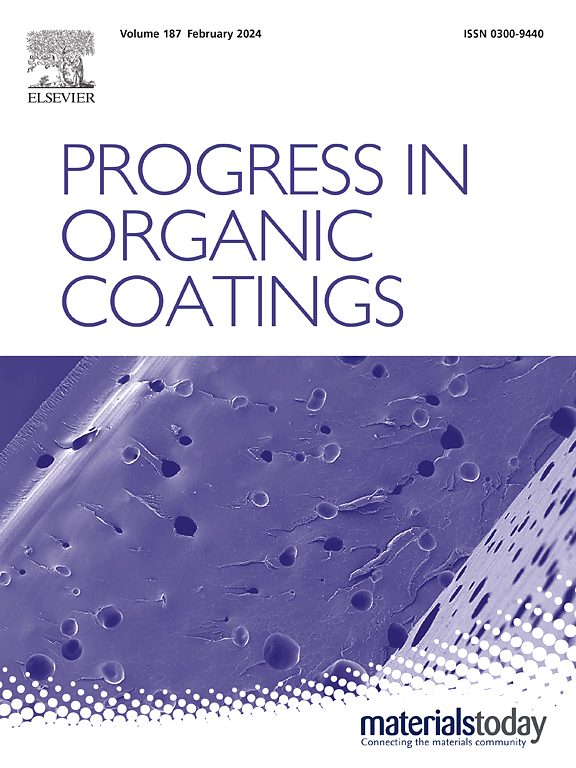Novel di-2-thienyl ketone derivatives photoinitiators enable fast visible light polymerization and 3D printing
IF 6.5
2区 材料科学
Q1 CHEMISTRY, APPLIED
引用次数: 0
Abstract
A series of Type II photoinitiators (PIs) bis(5-(4-(diethylamino)phenyl)thiophen-2-yl)methanone (EATM), bis(5-(9-ethyl-9H-carbazol-3-yl)thiophen-2-yl)methanone (ECTM) and bis(5-(4-(diphenylamino)phenyl)thiophen-2-yl)methanone (PATM) based on di-2-thienyl ketone were synthesized for the visible light photoploymerization. The maximum absorption wavelengths of EATM, ECTM and PATM in DMSO were 437 nm, 455 nm and 477 nm, respectively. The fast photopolymerization of polyethylene glycol diacrylate (PEGDA) could be initiated in a three-component system consisting of photoinitiator, diphenyliodonium hexafluorophosphate (Iod) and triethanolamine (TEOA) under visible light. The conversion rate of C![]() C bond under different light sources (405 nm, 440 nm and 480 nm) were measured by real-time Fourier transformed infrared spectroscopy (RT-FTIR). The C
C bond under different light sources (405 nm, 440 nm and 480 nm) were measured by real-time Fourier transformed infrared spectroscopy (RT-FTIR). The C![]() C bond conversion rate of PATM reached >93 % within 5 s, and the final conversion was up to 98 %, and the polymerization was completed in 10 s. The mechanism of light initiation was analyzed by density functional theory (DFT), steady-state photolysis and electron spin resonance spin trapping (ESR) experiments. Photobleaching, deep photocuring, migration ratio and cytotoxicity were evaluated. Three PIs were used to realize rapid 3D printing in an LCD 3D printer (405 nm). The printing rate was as high as 90 mm h−1 with exposure time 2 s/layer. This study provides ideas for the development of PIs for fast photopolymerization and 3D printing under visible light.
C bond conversion rate of PATM reached >93 % within 5 s, and the final conversion was up to 98 %, and the polymerization was completed in 10 s. The mechanism of light initiation was analyzed by density functional theory (DFT), steady-state photolysis and electron spin resonance spin trapping (ESR) experiments. Photobleaching, deep photocuring, migration ratio and cytotoxicity were evaluated. Three PIs were used to realize rapid 3D printing in an LCD 3D printer (405 nm). The printing rate was as high as 90 mm h−1 with exposure time 2 s/layer. This study provides ideas for the development of PIs for fast photopolymerization and 3D printing under visible light.

新型二-2-噻吩酮衍生物光引发剂可实现快速可见光聚合和 3D 打印
合成了一系列基于二-2-噻吩基酮的双(5-(4-(二乙基氨基)苯基)噻吩-2-基)甲酮(EATM)、双(5-(9-乙基-9H-咔唑-3-基)噻吩-2-基)甲酮(ECTM)和双(5-(4-(二苯基氨基)苯基)噻吩-2-基)甲酮(PATM),用于可见光光聚合。EATM、ECTM 和 PATM 在二甲基亚砜中的最大吸收波长分别为 437 nm、455 nm 和 477 nm。在可见光下,聚乙二醇二丙烯酸酯(PEGDA)可在由光引发剂、二苯碘六氟磷酸盐(Iod)和三乙醇胺(TEOA)组成的三组分体系中快速光聚合。通过实时傅立叶变换红外光谱(RT-FTIR)测量了不同光源(405 nm、440 nm 和 480 nm)下 CC 键的转化率。通过密度泛函理论(DFT)、稳态光解和电子自旋共振自旋捕获(ESR)实验分析了光引发的机理。评估了光漂白、深度光固化、迁移率和细胞毒性。使用三种光致抗蚀剂在液晶三维打印机(405 nm)上实现了快速三维打印。打印速率高达 90 mm h-1,曝光时间为 2 s/层。这项研究为开发用于可见光下快速光聚合和三维打印的 PI 提供了思路。
本文章由计算机程序翻译,如有差异,请以英文原文为准。
求助全文
约1分钟内获得全文
求助全文
来源期刊

Progress in Organic Coatings
工程技术-材料科学:膜
CiteScore
11.40
自引率
15.20%
发文量
577
审稿时长
48 days
期刊介绍:
The aim of this international journal is to analyse and publicise the progress and current state of knowledge in the field of organic coatings and related materials. The Editors and the Editorial Board members will solicit both review and research papers from academic and industrial scientists who are actively engaged in research and development or, in the case of review papers, have extensive experience in the subject to be reviewed. Unsolicited manuscripts will be accepted if they meet the journal''s requirements. The journal publishes papers dealing with such subjects as:
• Chemical, physical and technological properties of organic coatings and related materials
• Problems and methods of preparation, manufacture and application of these materials
• Performance, testing and analysis.
 求助内容:
求助内容: 应助结果提醒方式:
应助结果提醒方式:


